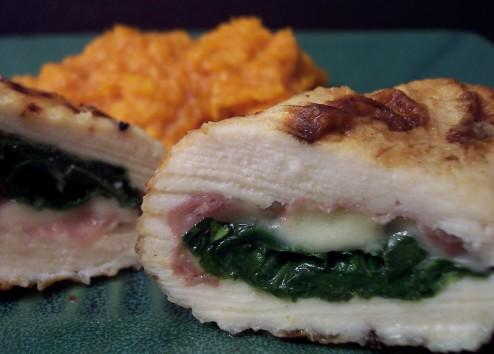Between eating them out-of-hand for snacks and using them in sweet recipes, we've pretty much run through all of our apple supply from our last picking trip. Before we left for PA a few weeks ago, we figured we better use them a savory way and this Apple and Leek Stuffed Pork Tenderloin was just the ticket.
 Stuffed inside our flattened plank of pork tenderloin is a mixture of leek, softened in extra-virgin olive oil, and a chopped sweet Honey Crisp apple with a bit of fresh thyme thrown in. The apple was added in with the leek to cook, but just for a brief two minutes - not long enough to make the apple mushy, but just enough to tame the crispness, leaving it barely tender. Before spreading it on the pork, be sure to give the chunky filling at least a few minutes to cool off.
Stuffed inside our flattened plank of pork tenderloin is a mixture of leek, softened in extra-virgin olive oil, and a chopped sweet Honey Crisp apple with a bit of fresh thyme thrown in. The apple was added in with the leek to cook, but just for a brief two minutes - not long enough to make the apple mushy, but just enough to tame the crispness, leaving it barely tender. Before spreading it on the pork, be sure to give the chunky filling at least a few minutes to cool off.If you've never had to butterfly a piece of tenderloin, there is no need for you to think it is at all complicated. All you'll need to do is halve the pork, lengthwise, yet hold back on slicing all the way though, which would split it in two pieces. You want one piece that you can open like a book, to which you'll cover with plastic wrap and whack the heck out of it to flatten the pork to an even thickness. Use a meat mallet if you have one, but a rolling pin, the bottom of a flat skillet or even a thick bottle will do the job.
 Filling the pork is just as easy as flattening it - the apple mixture goes down the center, the very ends of the tenderloin are folded in and the pork is rolled up like you would a jelly roll or cinnamon rolls. Folding the ends in first aids in keeping the apples inside, rather than falling out as you work with it. Because the tenderloin is seared on all sides before being slid in the oven to cook through, you will want to tie the roast with kitchen string to not only ensure it won't unravel as it is jostled about, but it helps to even the pork out so it cooks consistently. Seasoned, then seared in the same skillet the filling was made in, we transferred the pork to a baking sheet to finish in the oven. Why not just use the skillet to roast it in too? Well, as the pork bakes, we use the bits left behind in the skillet to start the outrageous pan sauce!
Filling the pork is just as easy as flattening it - the apple mixture goes down the center, the very ends of the tenderloin are folded in and the pork is rolled up like you would a jelly roll or cinnamon rolls. Folding the ends in first aids in keeping the apples inside, rather than falling out as you work with it. Because the tenderloin is seared on all sides before being slid in the oven to cook through, you will want to tie the roast with kitchen string to not only ensure it won't unravel as it is jostled about, but it helps to even the pork out so it cooks consistently. Seasoned, then seared in the same skillet the filling was made in, we transferred the pork to a baking sheet to finish in the oven. Why not just use the skillet to roast it in too? Well, as the pork bakes, we use the bits left behind in the skillet to start the outrageous pan sauce!We poured applejack, a snappy brandy, into the skillet and tossed in a couple crushed cloves of garlic and a whole sprig of fresh thyme to echo the flavor inside of the rolled pork. Once the liquid came to a boil, loosening those tasty bits stuck on the bottom of the pan, we whisked in a mixture of apple cider and cornstarch, then let the sauce reduce by about half (you should have about 3/4 cup of liquid left when it is ready). By this point, the tenderloin will have roasted through and begun to rest, which leaves us just enough time to round out the slightly thickened sauce. Since we just wanted a whisper of garlic and thyme, those are whisked away, while a dollop of tangy Dijon was added back in, along with any of the intense juices that accumulated on the baking sheet the pork was cooked on.
 Sliced into thick, lightly pink-hued elegant rounds, we served the pork on a warm pool of the sauce, with a little drizzled over the top for good measure. Perfect to serve for a fancy dinner or just as an everyday meal, Jeff and I both swooned over the tender pork and the zesty sauce. If you can't find applejack or don't wish to use alcohol, you can simply use the same amount of apple cider, but do note that the sauce will have slightly less punch.
Sliced into thick, lightly pink-hued elegant rounds, we served the pork on a warm pool of the sauce, with a little drizzled over the top for good measure. Perfect to serve for a fancy dinner or just as an everyday meal, Jeff and I both swooned over the tender pork and the zesty sauce. If you can't find applejack or don't wish to use alcohol, you can simply use the same amount of apple cider, but do note that the sauce will have slightly less punch.Recipes






















I'm sure the pork and apple are delicious, but the sauce sounds FANTASTIC!
ReplyDeleteLois - It was!
ReplyDelete